The Government of Scotland Historical government of
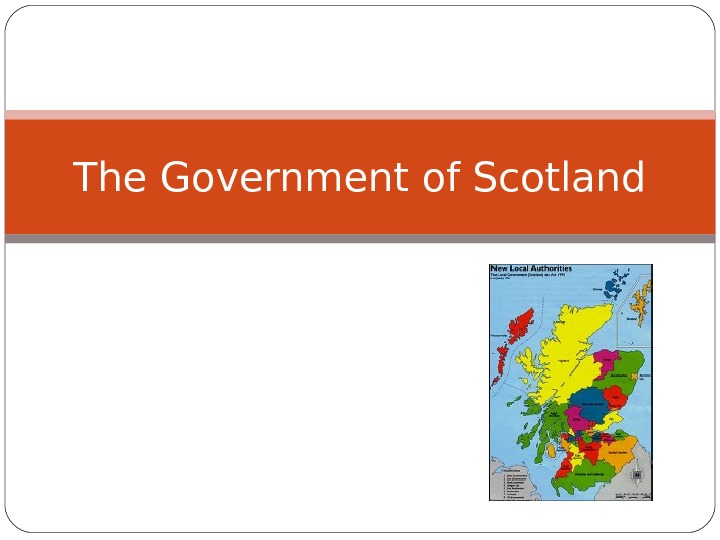
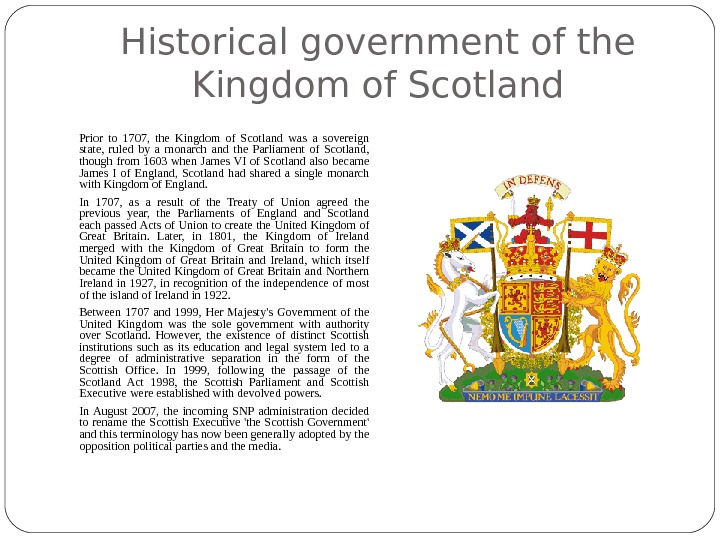
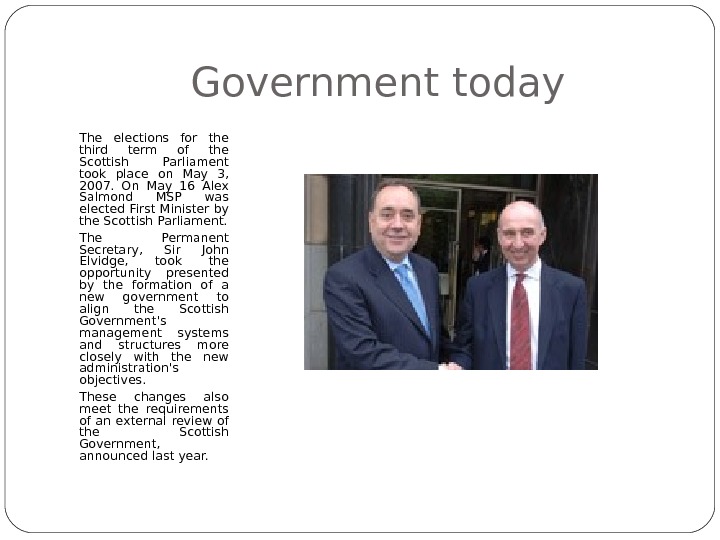
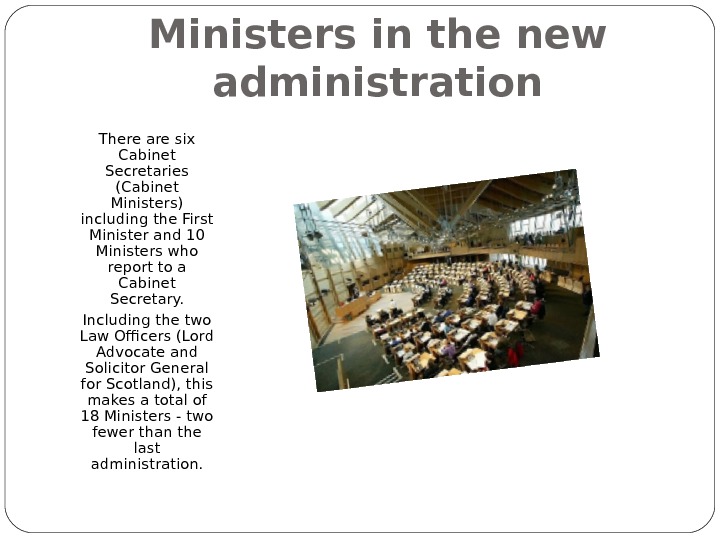
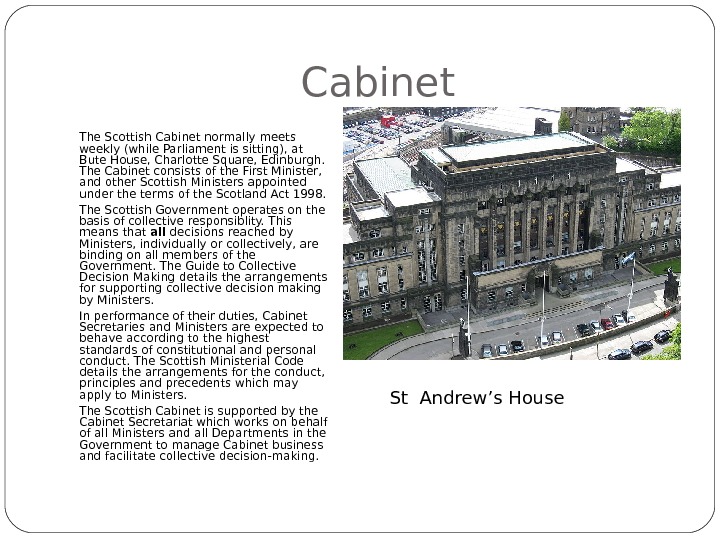
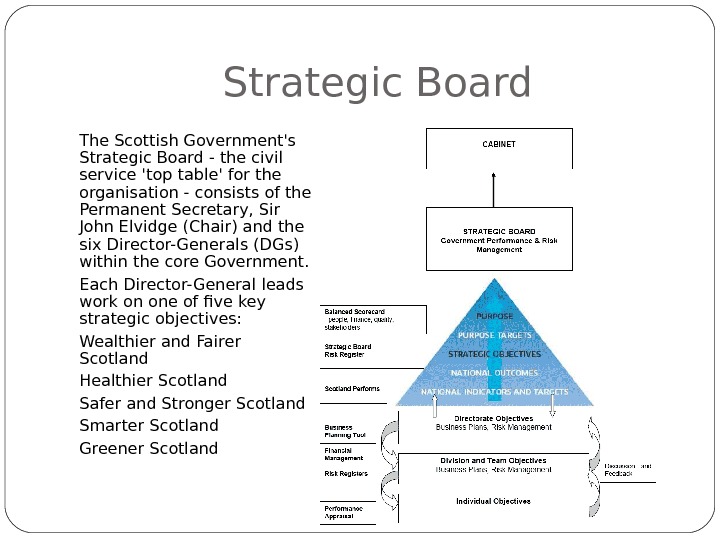
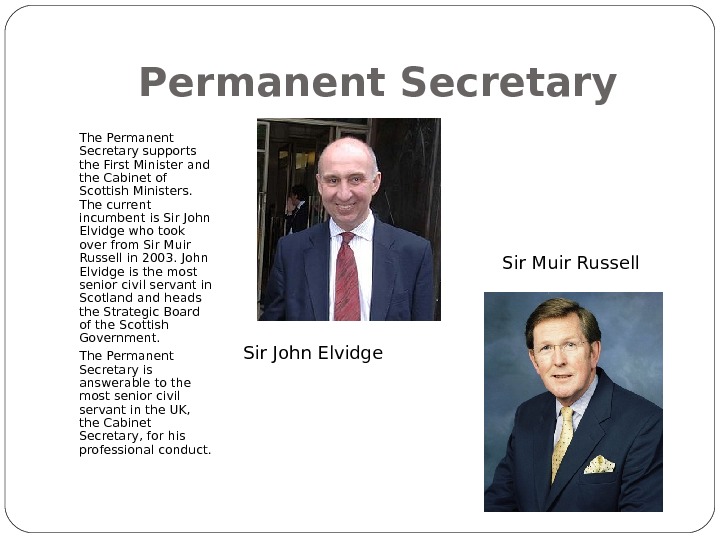
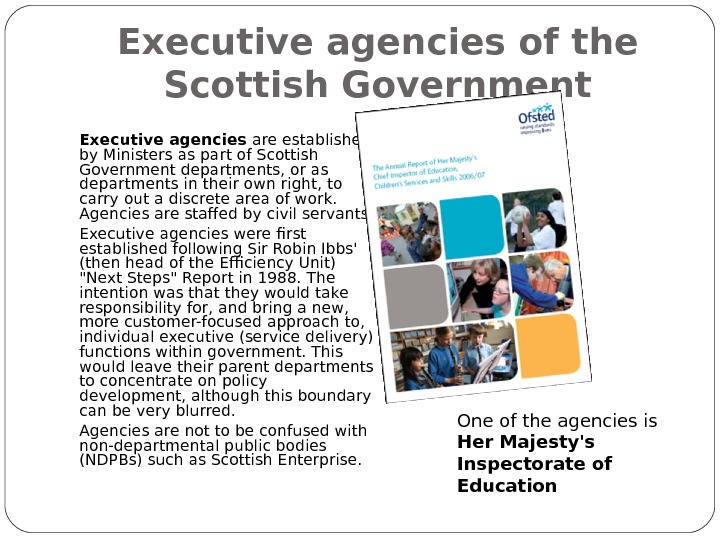
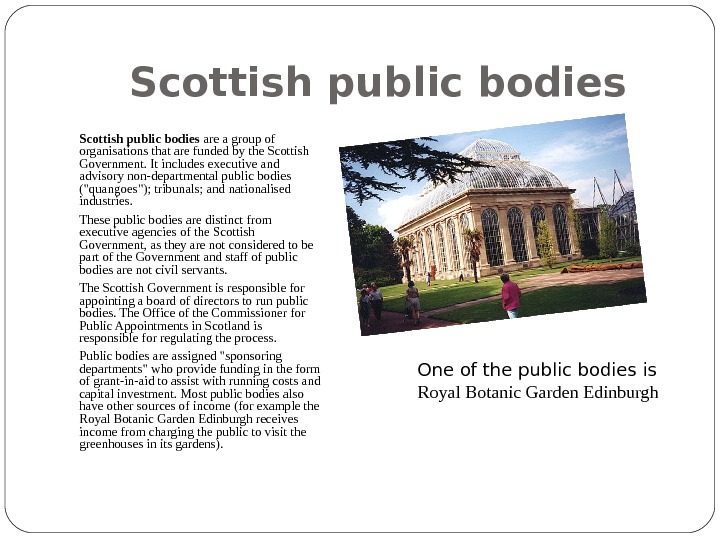
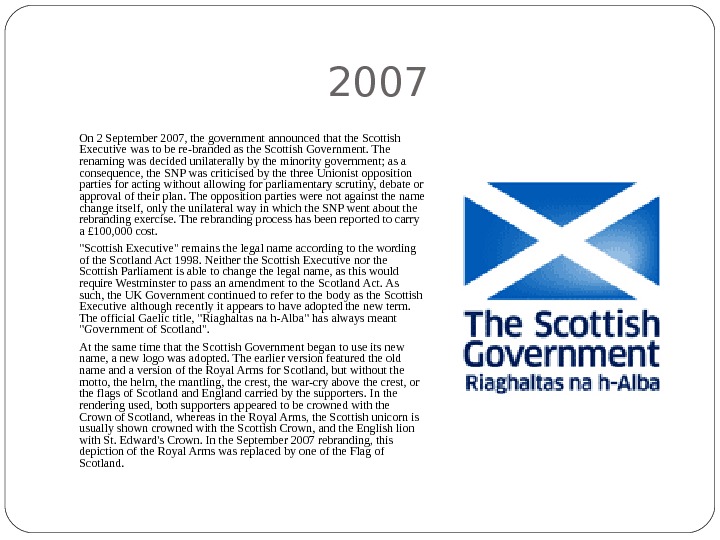

the-government-of-scotland.ppt
- Размер: 1 Mегабайта
- Количество слайдов: 11
Описание презентации The Government of Scotland Historical government of по слайдам
 The Government of Scotland
The Government of Scotland
 Historical government of the Kingdom of Scotland Prior to 1707, the Kingdom of Scotland was a sovereign state, ruled by a monarch and the Parliament of Scotland, though from 1603 when James VI of Scotland also became James I of England, Scotland had shared a single monarch with Kingdom of England. In 1707, as a result of the Treaty of Union agreed the previous year, the Parliaments of England Scotland each passed Acts of Union to create the United Kingdom of Great Britain. Later, in 1801, the Kingdom of Ireland merged with the Kingdom of Great Britain to form the United Kingdom of Great Britain and Ireland, which itself became the United Kingdom of Great Britain and Northern Ireland in 1927, in recognition of the independence of most of the island of Ireland in 1922. Between 1707 and 1999, Her Majesty’s Government of the United Kingdom was the sole government with authority over Scotland. However, the existence of distinct Scottish institutions such as its education and legal system led to a degree of administrative separation in the form of the Scottish Office. In 1999, following the passage of the Scotland Act 1998, the Scottish Parliament and Scottish Executive were established with devolved powers. In August 2007, the incoming SNP administration decided to rename the Scottish Executive ‘the Scottish Government’ and this terminology has now been generally adopted by the opposition political parties and the media.
Historical government of the Kingdom of Scotland Prior to 1707, the Kingdom of Scotland was a sovereign state, ruled by a monarch and the Parliament of Scotland, though from 1603 when James VI of Scotland also became James I of England, Scotland had shared a single monarch with Kingdom of England. In 1707, as a result of the Treaty of Union agreed the previous year, the Parliaments of England Scotland each passed Acts of Union to create the United Kingdom of Great Britain. Later, in 1801, the Kingdom of Ireland merged with the Kingdom of Great Britain to form the United Kingdom of Great Britain and Ireland, which itself became the United Kingdom of Great Britain and Northern Ireland in 1927, in recognition of the independence of most of the island of Ireland in 1922. Between 1707 and 1999, Her Majesty’s Government of the United Kingdom was the sole government with authority over Scotland. However, the existence of distinct Scottish institutions such as its education and legal system led to a degree of administrative separation in the form of the Scottish Office. In 1999, following the passage of the Scotland Act 1998, the Scottish Parliament and Scottish Executive were established with devolved powers. In August 2007, the incoming SNP administration decided to rename the Scottish Executive ‘the Scottish Government’ and this terminology has now been generally adopted by the opposition political parties and the media.
 Government today The elections for the third term of the Scottish Parliament took place on May 3, 2007. On May 16 Alex Salmond MSP was elected First Minister by the Scottish Parliament. The Permanent Secretary, Sir John Elvidge, took the opportunity presented by the formation of a new government to align the Scottish Government’s management systems and structures more closely with the new administration’s objectives. These changes also meet the requirements of an external review of the Scottish Government, announced last year.
Government today The elections for the third term of the Scottish Parliament took place on May 3, 2007. On May 16 Alex Salmond MSP was elected First Minister by the Scottish Parliament. The Permanent Secretary, Sir John Elvidge, took the opportunity presented by the formation of a new government to align the Scottish Government’s management systems and structures more closely with the new administration’s objectives. These changes also meet the requirements of an external review of the Scottish Government, announced last year.
 Ministers in the new administration There are six Cabinet Secretaries (Cabinet Ministers) including the First Minister and 10 Ministers who report to a Cabinet Secretary. Including the two Law Officers (Lord Advocate and Solicitor General for Scotland), this makes a total of 18 Ministers — two fewer than the last administration.
Ministers in the new administration There are six Cabinet Secretaries (Cabinet Ministers) including the First Minister and 10 Ministers who report to a Cabinet Secretary. Including the two Law Officers (Lord Advocate and Solicitor General for Scotland), this makes a total of 18 Ministers — two fewer than the last administration.
 Cabinet The Scottish Cabinet normally meets weekly (while Parliament is sitting), at Bute House, Charlotte Square, Edinburgh. The Cabinet consists of the First Minister, and other Scottish Ministers appointed under the terms of the Scotland Act 1998. The Scottish Government operates on the basis of collective responsiblity. This means that all decisions reached by Ministers, individually or collectively, are binding on all members of the Government. The Guide to Collective Decision Making details the arrangements for supporting collective decision making by Ministers. In performance of their duties, Cabinet Secretaries and Ministers are expected to behave according to the highest standards of constitutional and personal conduct. The Scottish Ministerial Code details the arrangements for the conduct, principles and precedents which may apply to Ministers. The Scottish Cabinet is supported by the Cabinet Secretariat which works on behalf of all Ministers and all Departments in the Government to manage Cabinet business and facilitate collective decision-making. St Andrew’s House
Cabinet The Scottish Cabinet normally meets weekly (while Parliament is sitting), at Bute House, Charlotte Square, Edinburgh. The Cabinet consists of the First Minister, and other Scottish Ministers appointed under the terms of the Scotland Act 1998. The Scottish Government operates on the basis of collective responsiblity. This means that all decisions reached by Ministers, individually or collectively, are binding on all members of the Government. The Guide to Collective Decision Making details the arrangements for supporting collective decision making by Ministers. In performance of their duties, Cabinet Secretaries and Ministers are expected to behave according to the highest standards of constitutional and personal conduct. The Scottish Ministerial Code details the arrangements for the conduct, principles and precedents which may apply to Ministers. The Scottish Cabinet is supported by the Cabinet Secretariat which works on behalf of all Ministers and all Departments in the Government to manage Cabinet business and facilitate collective decision-making. St Andrew’s House
 Strategic Board The Scottish Government’s Strategic Board — the civil service ‘top table’ for the organisation — consists of the Permanent Secretary, Sir John Elvidge (Chair) and the six Director-Generals (DGs) within the core Government. Each Director-General leads work on one of five key strategic objectives: Wealthier and Fairer Scotland Healthier Scotland Safer and Stronger Scotland Smarter Scotland Greener Scotland
Strategic Board The Scottish Government’s Strategic Board — the civil service ‘top table’ for the organisation — consists of the Permanent Secretary, Sir John Elvidge (Chair) and the six Director-Generals (DGs) within the core Government. Each Director-General leads work on one of five key strategic objectives: Wealthier and Fairer Scotland Healthier Scotland Safer and Stronger Scotland Smarter Scotland Greener Scotland
 Permanent Secretary The Permanent Secretary supports the First Minister and the Cabinet of Scottish Ministers. The current incumbent is Sir John Elvidge who took over from Sir Muir Russell in 2003. John Elvidge is the most senior civil servant in Scotland heads the Strategic Board of the Scottish Government. The Permanent Secretary is answerable to the most senior civil servant in the UK, the Cabinet Secretary, for his professional conduct. Sir John Elvidge Sir Muir Russell
Permanent Secretary The Permanent Secretary supports the First Minister and the Cabinet of Scottish Ministers. The current incumbent is Sir John Elvidge who took over from Sir Muir Russell in 2003. John Elvidge is the most senior civil servant in Scotland heads the Strategic Board of the Scottish Government. The Permanent Secretary is answerable to the most senior civil servant in the UK, the Cabinet Secretary, for his professional conduct. Sir John Elvidge Sir Muir Russell
 Executive agencies of the Scottish Government Executive agencies are established by Ministers as part of Scottish Government departments, or as departments in their own right, to carry out a discrete area of work. Agencies are staffed by civil servants. Executive agencies were first established following Sir Robin Ibbs’ (then head of the Efficiency Unit) «Next Steps» Report in 1988. The intention was that they would take responsibility for, and bring a new, more customer-focused approach to, individual executive (service delivery) functions within government. This would leave their parent departments to concentrate on policy development, although this boundary can be very blurred. Agencies are not to be confused with non-departmental public bodies (NDPBs) such as Scottish Enterprise. One of the agencies is Her Majesty’s Inspectorate of Education
Executive agencies of the Scottish Government Executive agencies are established by Ministers as part of Scottish Government departments, or as departments in their own right, to carry out a discrete area of work. Agencies are staffed by civil servants. Executive agencies were first established following Sir Robin Ibbs’ (then head of the Efficiency Unit) «Next Steps» Report in 1988. The intention was that they would take responsibility for, and bring a new, more customer-focused approach to, individual executive (service delivery) functions within government. This would leave their parent departments to concentrate on policy development, although this boundary can be very blurred. Agencies are not to be confused with non-departmental public bodies (NDPBs) such as Scottish Enterprise. One of the agencies is Her Majesty’s Inspectorate of Education
 Scottish public bodies are a group of organisations that are funded by the Scottish Government. It includes executive and advisory non-departmental public bodies («quangoes»); tribunals; and nationalised industries. These public bodies are distinct from executive agencies of the Scottish Government, as they are not considered to be part of the Government and staff of public bodies are not civil servants. The Scottish Government is responsible for appointing a board of directors to run public bodies. The Office of the Commissioner for Public Appointments in Scotland is responsible for regulating the process. Public bodies are assigned «sponsoring departments» who provide funding in the form of grant-in-aid to assist with running costs and capital investment. Most public bodies also have other sources of income (for example the Royal Botanic Garden Edinburgh receives income from charging the public to visit the greenhouses in its gardens). One of the public bodies is Royal Botanic Garden Edinburgh
Scottish public bodies are a group of organisations that are funded by the Scottish Government. It includes executive and advisory non-departmental public bodies («quangoes»); tribunals; and nationalised industries. These public bodies are distinct from executive agencies of the Scottish Government, as they are not considered to be part of the Government and staff of public bodies are not civil servants. The Scottish Government is responsible for appointing a board of directors to run public bodies. The Office of the Commissioner for Public Appointments in Scotland is responsible for regulating the process. Public bodies are assigned «sponsoring departments» who provide funding in the form of grant-in-aid to assist with running costs and capital investment. Most public bodies also have other sources of income (for example the Royal Botanic Garden Edinburgh receives income from charging the public to visit the greenhouses in its gardens). One of the public bodies is Royal Botanic Garden Edinburgh
 2007 On 2 September 2007, the government announced that the Scottish Executive was to be re-branded as the Scottish Government. The renaming was decided unilaterally by the minority government; as a consequence, the SNP was criticised by the three Unionist opposition parties for acting without allowing for parliamentary scrutiny, debate or approval of their plan. The opposition parties were not against the name change itself, only the unilateral way in which the SNP went about the rebranding exercise. The rebranding process has been reported to carry a £ 100, 000 cost. «Scottish Executive» remains the legal name according to the wording of the Scotland Act 1998. Neither the Scottish Executive nor the Scottish Parliament is able to change the legal name, as this would require Westminster to pass an amendment to the Scotland Act. As such, the UK Government continued to refer to the body as the Scottish Executive although recently it appears to have adopted the new term. The official Gaelic title, «Riaghaltas na h-Alba» has always meant «Government of Scotland». At the same time that the Scottish Government began to use its new name, a new logo was adopted. The earlier version featured the old name and a version of the Royal Arms for Scotland, but without the motto, the helm, the mantling, the crest, the war-cry above the crest, or the flags of Scotland England carried by the supporters. In the rendering used, both supporters appeared to be crowned with the Crown of Scotland, whereas in the Royal Arms, the Scottish unicorn is usually shown crowned with the Scottish Crown, and the English lion with St. Edward’s Crown. In the September 2007 rebranding, this depiction of the Royal Arms was replaced by one of the Flag of Scotland.
2007 On 2 September 2007, the government announced that the Scottish Executive was to be re-branded as the Scottish Government. The renaming was decided unilaterally by the minority government; as a consequence, the SNP was criticised by the three Unionist opposition parties for acting without allowing for parliamentary scrutiny, debate or approval of their plan. The opposition parties were not against the name change itself, only the unilateral way in which the SNP went about the rebranding exercise. The rebranding process has been reported to carry a £ 100, 000 cost. «Scottish Executive» remains the legal name according to the wording of the Scotland Act 1998. Neither the Scottish Executive nor the Scottish Parliament is able to change the legal name, as this would require Westminster to pass an amendment to the Scotland Act. As such, the UK Government continued to refer to the body as the Scottish Executive although recently it appears to have adopted the new term. The official Gaelic title, «Riaghaltas na h-Alba» has always meant «Government of Scotland». At the same time that the Scottish Government began to use its new name, a new logo was adopted. The earlier version featured the old name and a version of the Royal Arms for Scotland, but without the motto, the helm, the mantling, the crest, the war-cry above the crest, or the flags of Scotland England carried by the supporters. In the rendering used, both supporters appeared to be crowned with the Crown of Scotland, whereas in the Royal Arms, the Scottish unicorn is usually shown crowned with the Scottish Crown, and the English lion with St. Edward’s Crown. In the September 2007 rebranding, this depiction of the Royal Arms was replaced by one of the Flag of Scotland.
 Thank you for your attention!
Thank you for your attention!
